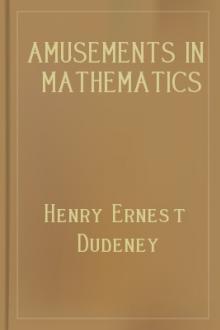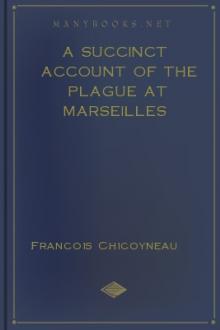Amusements in Mathematics, Henry Ernest Dudeney [books to read to be successful txt] 📗

- Author: Henry Ernest Dudeney
- Performer: 0486204731
Book online «Amusements in Mathematics, Henry Ernest Dudeney [books to read to be successful txt] 📗». Author Henry Ernest Dudeney
65.—THE RAILWAY STATION CLOCK.—solution
The time must have been 437/11 min. past two o'clock.
66.—THE VILLAGE SIMPLETON.—solution
The day of the week on which the conversation took place was Sunday. For when the day after to-morrow (Tuesday) is "yesterday," "to-day" will be Wednesday; and when the day before yesterday (Friday) was "to-morrow," "to-day" was Thursday. There are two days between Thursday and Sunday, and between Sunday and Wednesday.
67.—AVERAGE SPEED.—solution
The average speed is twelve miles an hour, not twelve and a half, as most people will hastily declare. Take any distance you like, say sixty miles. This would have taken six hours going and four hours returning. The double journey of 120 miles would thus take ten hours, and the average speed is clearly twelve miles an hour.
68.—THE TWO TRAINS.—solution
One train was running just twice as fast as the other.
69.—THE THREE VILLAGES.—solution
Calling the three villages by their initial letters, it is clear that the three roads form a triangle, A, B, C, with a perpendicular, measuring twelve miles, dropped from C to the base A, B. This divides our triangle into two right-angled triangles with a twelve-mile side in common. It is then found that the distance from A to C is 15 miles, from C to B 20 miles, and from A to B 25 (that is 9 and 16) miles. These figures are easily proved, for the square of 12 added to the square of 9 equals the square of 15, and the square of 12 added to the square of 16 equals the square of 20.
70.—DRAWING HER PENSION.—solution
The distance must be 6¾ miles.
71.—SIR EDWYN DE TUDOR.—solution
The distance must have been sixty miles. If Sir Edwyn left at noon and rode 15 miles an hour, he would arrive at four o'clock—an hour too soon. If he rode 10 miles an hour, he would arrive at six o'clock—an hour too late. But if he went at 12 miles an hour, he would reach the castle of the wicked baron exactly at five o'clock—the time appointed.
72.—THE HYDROPLANE QUESTION.—solution
The machine must have gone at the rate of seven-twenty-fourths of a mile per minute and the wind travelled five-twenty-fourths of a mile per minute. Thus, going, the wind would help, and the machine would do twelve-twenty-fourths, or half a mile a minute, and returning only two-twenty-fourths, or one-twelfth of a mile per minute, the wind being against it. The machine without any wind could therefore do the ten miles in thirty-four and two-sevenths minutes, since it could do seven miles in twenty-four minutes.
73.—DONKEY RIDING.—solution
The complete mile was run in nine minutes. From the facts stated we cannot determine the time taken over the first and second quarter-miles separately, but together they, of course, took four and a half minutes. The last two quarters were run in two and a quarter minutes each.
74.—THE BASKET OF POTATOES.—solution
Multiply together the number of potatoes, the number less one, and twice the number less one, then divide by 3. Thus 50, 49, and 99 multiplied together make 242,550, which, divided by 3, gives us 80,850 yards as the correct answer. The boy would thus have to travel 45 miles and fifteen-sixteenths—a nice little recreation after a day's work.
75.—THE PASSENGER'S FARE.—solution
Mr. Tompkins should have paid fifteen shillings as his correct share of the motor-car fare. He only shared half the distance travelled for £3, and therefore should pay half of thirty shillings, or fifteen shillings.
76.—THE BARREL OF BEER.—solution
Here the digital roots of the six numbers are 6, 4, 1, 2, 7, 9, which together sum to 29, whose digital root is 2. As the contents of the barrels sold must be a number divisible by 3, if one buyer purchased twice as much as the other, we must find a barrel with root 2, 5, or 8 to set on one side. There is only one barrel, that containing 20 gallons, that fulfils these conditions. So the man must have kept these 20 gallons of beer for his own use and sold one man 33 gallons (the 18-gallon and 15-gallon barrels) and sold the other man 66 gallons (the 16, 19, and 31 gallon barrels).
77.—DIGITS AND SQUARES.—solution
The top row must be one of the four following numbers: 192, 219, 273, 327. The first was the example given.
78.—ODD AND EVEN DIGITS.—solution
As we have to exclude complex and improper fractions and recurring decimals, the simplest solution is this: 79 + 51/3 and 84 + 2/6, both equal 841/3. Without any use of fractions it is obviously impossible.
79.—THE LOCKERS PUZZLE.—solution
The smallest possible total is 356 = 107 + 249, and the largest sum possible is 981 = 235 + 746, or 657 + 324. The middle sum may be either 720 =134+586, or 702 = 134 + 568, or 407 = 138 + 269. The total in this case must be made up of three of the figures 0, 2, 4, 7, but no sum other than the three given can possibly be obtained. We have therefore no choice in the case of the first locker, an alternative in the case of the third, and any one of three arrangements in the case of the middle locker. Here is one solution:—
Of course, in each case figures in the first two lines may be exchanged vertically without altering the total, and as a result there are just 3,072 different ways in which the figures might be actually placed on the locker doors. I must content myself with showing one little principle involved in this puzzle. The sum of the digits in the total is always governed by the digit omitted. 9/9 - 7/10 - 5/11 - 3/12 - 1/13 - 8/14 - 6/15 - 4/16 - 2/17 - 0/18. Whichever digit shown here in the upper line we omit, the sum of the digits in the total will be found beneath it. Thus in the case of locker A we omitted 8, and the figures in the total sum up to 14. If, therefore, we wanted to get 356, we may know at once to a certainty that it can only be obtained (if at all) by dropping the 8.
80.—THE THREE GROUPS.—solution
There are nine solutions to this puzzle, as follows, and no more:—
The seventh answer is the one that is most likely to be overlooked by solvers of the puzzle.
81.—THE NINE COUNTERS.—solution
In this case a certain amount of mere "trial" is unavoidable. But there are two kinds of "trials"—those that are purely haphazard, and those that are methodical. The true puzzle lover is never satisfied with mere haphazard trials. The reader will find that by just reversing the figures in 23 and 46 (making the multipliers 32 and 64) both products will be 5,056. This is an improvement, but it is not the correct answer. We can get as large a product as 5,568 if we multiply 174 by 32 and 96 by 58, but this solution is not to be found without the exercise of some judgment and patience.
82.—THE TEN COUNTERS.—solution
As I pointed out, it is quite easy so to arrange the counters that they shall form a pair of simple multiplication sums, each of which will give the same product—in fact, this can be done by anybody in five minutes with a little patience. But it is quite another matter to find that pair which gives the largest product and that which gives the smallest product.
Now, in order to get the smallest product, it is necessary to select as multipliers the two smallest possible numbers. If, therefore, we place 1 and 2 as multipliers, all we have to do is to arrange the remaining eight counters in such a way that they shall form two numbers, one of which is just double the other; and in doing this we must, of course, try to make the smaller number as low as possible. Of course the lowest number we could get would be 3,045; but this will not work, neither will 3,405, 3,450, etc., and it may be ascertained that 3,485 is the lowest possible. One of the required answers is 3,485 × 2 = 6,970, and 6,970 × 1 = 6,970.
The other part of the puzzle (finding the pair with the highest product) is, however, the real knotty point, for it is not at all easy to discover whether we should let the multiplier consist of one or of two figures, though it is clear that we must keep, so far as we can, the largest figures to the left in both multiplier and multiplicand. It will be seen that by the following arrangement so high a number as 58,560 may be obtained. Thus, 915 × 64 = 58,560, and 732 × 80 = 58,560.
83.—DIGITAL MULTIPLICATION.—solution
The solution that gives the smallest possible sum of digits in the common product is 23 × 174 = 58 × 69 = 4,002, and the solution that gives the largest possible sum of digits, 9 × 654 = 18 × 327 = 5,886. In the first case the digits sum to 6 and in the second case to 27. There is no way of obtaining the solution but by actual trial.
84.—THE PIERROT'S PUZZLE.—solution
There are just six different solutions to this puzzle, as follows:—
It will be seen that in every case the two multipliers contain exactly the same figures as the product.
85.—THE CAB NUMBERS.—solution
The highest product is, I think, obtained by multiplying 8,745,231 by 96—namely, 839,542,176.
Dealing here with the problem generally, I have shown in the last puzzle that with three digits there are only two possible solutions, and with four digits only six different solutions.
These cases have all been given. With five digits there are just twenty-two solutions, as follows:—
Now, if we took every possible combination and tested it by multiplication, we should need to make no fewer than 30,240 trials, or, if we at once rejected the number 1 as a multiplier, 28,560 trials—a task that I think most people would be inclined to shirk. But let us consider whether there be no shorter way of getting at





Comments (0)